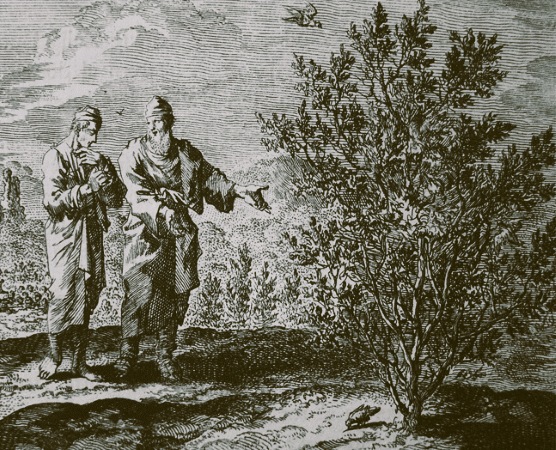One of Jesus’ shorter, but for some reason, best remembered parables, is that of the Mustard Seed. Yet, like many of his better-known images, this one is a little shocking.
The seeds of mustard plants can be ground to create the yellow condiment that goes best with hot dogs and the leaves are edible, too. Mustard has been quietly cultivated for a long time. But in his day, it is said to have been considered little more than a mere weed by farmers. And it is a short weed at that, not even a shrub. So to picture mustard seed as being deliberately sown and then to become a mighty tree is an even more perplexing image.
Maybe this is why Mustard Seed story was so well remembered. It is one of the first parables that appears almost the same in Matthew, Mark, and Luke. The setting is the same in the first two — said during Jesus’ preaching from the boat — but Luke places it right after Jesus cures a bent-over woman in the synagogue.
Interestingly, it’s not the only time Jesus uses the image of the mustard seed. He also uses it as an image of faith sufficient to uproot trees and move mountains. Big things start small.
Perhaps these differences can provide insights into how the telling affects a symbolic rendition. So, let us apply the Term Substitution Method to all three versions.
Matthew
He set another parable before them, saying, “The Kingdom of Heaven is like a grain of mustard seed which a man took, and sowed in his field, which indeed is smaller than all seeds. But when it is grown, it is greater than the herbs and becomes a tree, so that the birds of the air come and lodge in its branches.” Matt. 13:31-32
Here’s how Matthew’s version might look after TSM, with brackets identifying the changed terms:
He set another parable before them: “The [presence of God] is a [nourishing teaching] of [heavenly doctrine] which a [sinner] [accepted], and [believed] in his [soul], which indeed is smaller than all [doctrines]. But when it is grown, it is greater than the [sects] and becomes [the Church], so that the [spiritual souls that can fly to heavenly knowledge] come and [rest overlooking] in the [churches founded by the Apostles].”
Mark
He said, “How will we liken God’s Kingdom? Or with what parable will we illustrate it? It’s like a grain of mustard seed, which, when it is sown in the earth, though it is less than all the seeds that are on the earth, yet when it is sown, grows up, and becomes greater than all the herbs, and puts out great branches, so that the birds of the sky can lodge under its shadow.” Mark 4:30-32
Again, substituting allegorical terms for the plain text:
He said, “How will we liken [God’s reign]? Or with what parable will we illustrate it? It’s like a [nourishing doctrine] of [the risen Christ], which, when it is [preached] to [souls of sinners], though it is less than all the [doctrines] that are of the [souls of sinners], yet when it is [preached], grows up, and becomes greater than all the [teachings for the spiritually weaned], and puts out great [churches founded by the Apostles], so that the [pure souls] can [rest] under its [protection].”
Luke
He said, “What is God’s Kingdom like? To what shall I compare it? It is like a grain of mustard seed which a man took and put in his own garden. It grew and became a large tree, and the birds of the sky live in its branches.” Luke 13:18-19
Now after TSM:
He said, “What is God’s [living presence] like? To what shall I compare it? It is like a [nourishing teaching] of [heavenly doctrine] which a man [accepted] and put in his own [family]. It grew and became a large [Church], and the [angels and lofty spirits] live in its [heirs].”
The differences in interpretation between these three variants are subtle, but they are there. All three are about the growth of the Church. But Mark makes it about the entire Church, while Matthew emphasizes the individual believer, and Luke makes it more about a family. Whether such differences are real or significant is another question, for the results in all three are similar. But at least that makes for reassuring consistency.
The problem is that many words used in the Spiritual Code are over-defined while most are not defined at all. There must be rules to guide the results. Terms that are opposed (like “night” and “day”) must be used the same way. For example, if “night” is taken to mean “the present era”, “day” cannot possibly mean “joy” or “prosperity” but simply “the age to come”.
Of course, whether the term is used positively or otherwise is of vital importance. But terms and their definitions must be used the same in any one reading, so “earth” should not at one point be defined as “souls of sinners” but redefined as “flesh” if it appears again in the next verse, even if both terms are used negatively.
Some might object that this means these results are forced, cherry-picked to read the same. Yes, of course, they are. That does not make them useless, however. Every interpretation of anything in Scripture is somewhat forced. TSM, however, makes use of what the deep traditions of Christian preaching and hermeneutics have come up with.
But though I sought to use different definitions in each reading — and there may be far better symbolic interpretations possible — I was constrained by the text itself.
For example, “birds” can also mean “devils”, “philosophers”, “proud, lawless people” and “wicked spirits” among other things, according to The Word Unveiled. That would radically alter the meaning, but there is nothing in the context to justify such a substitution. After all, one certainly hopes that Jesus would never be talking about the Kingdom of Heaven being full of wicked spirits.
Not only that, Jesus’ only other references to mustard seeds as the germs of powerful, world-changing faith also confirm this positivity. Mustard itself is defined as “the Word of God that represses pride” by the Fathers. Thus all the basic references are overwhelmingly positive. To turn it around would do violence to the text.
So it appears that the Term Substitution Method really does “cut the mustard“, which means “to reach or surpass the desired standard or performance”. With appropriate choices, TSM can render parables into a plain-text reading that can be helpful, while stripping away two millennia of muddled preaching for pastoral agendas. Maybe it even approaches what the Savior actually intended to say, which would certainly make it of some value.
But is that all? Can it reveal surprises and point to things not previously considered? If so, maybe the Spiritual Code can be uncovered after all.

